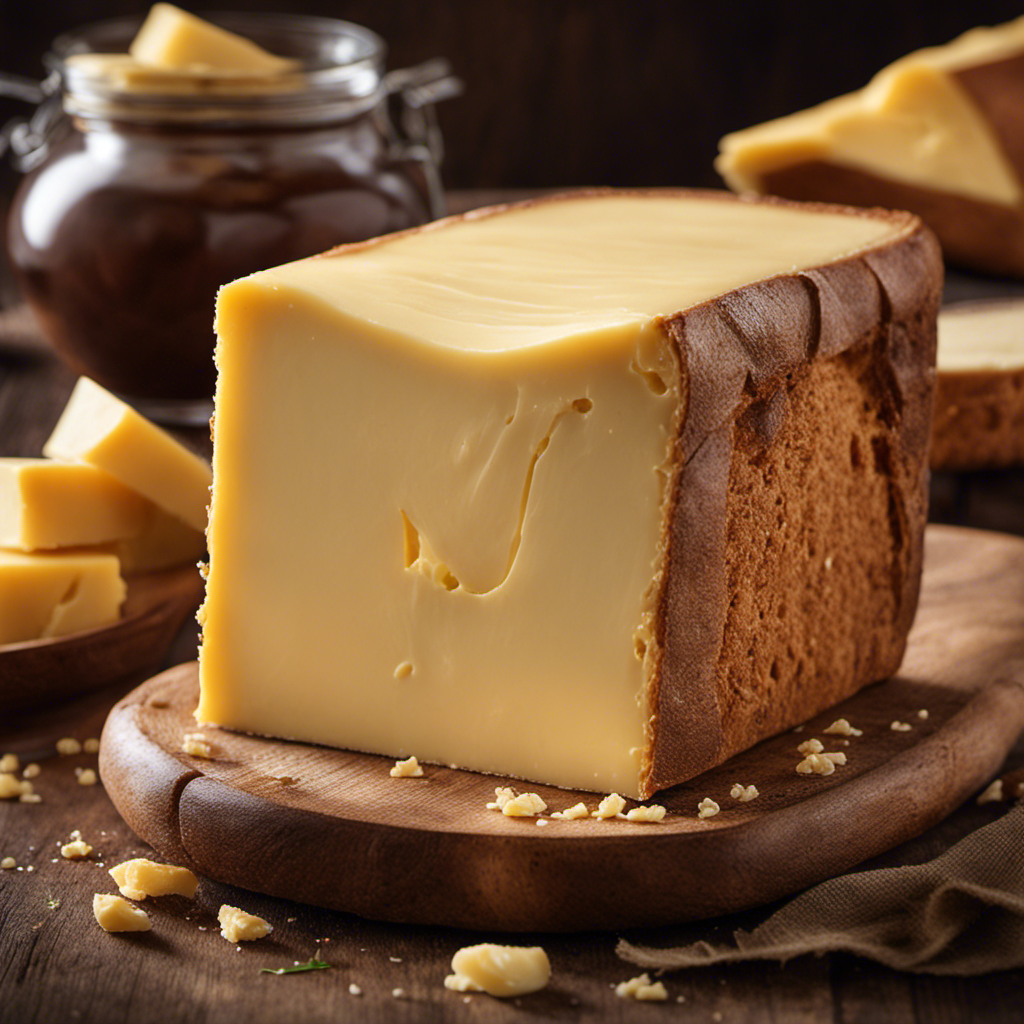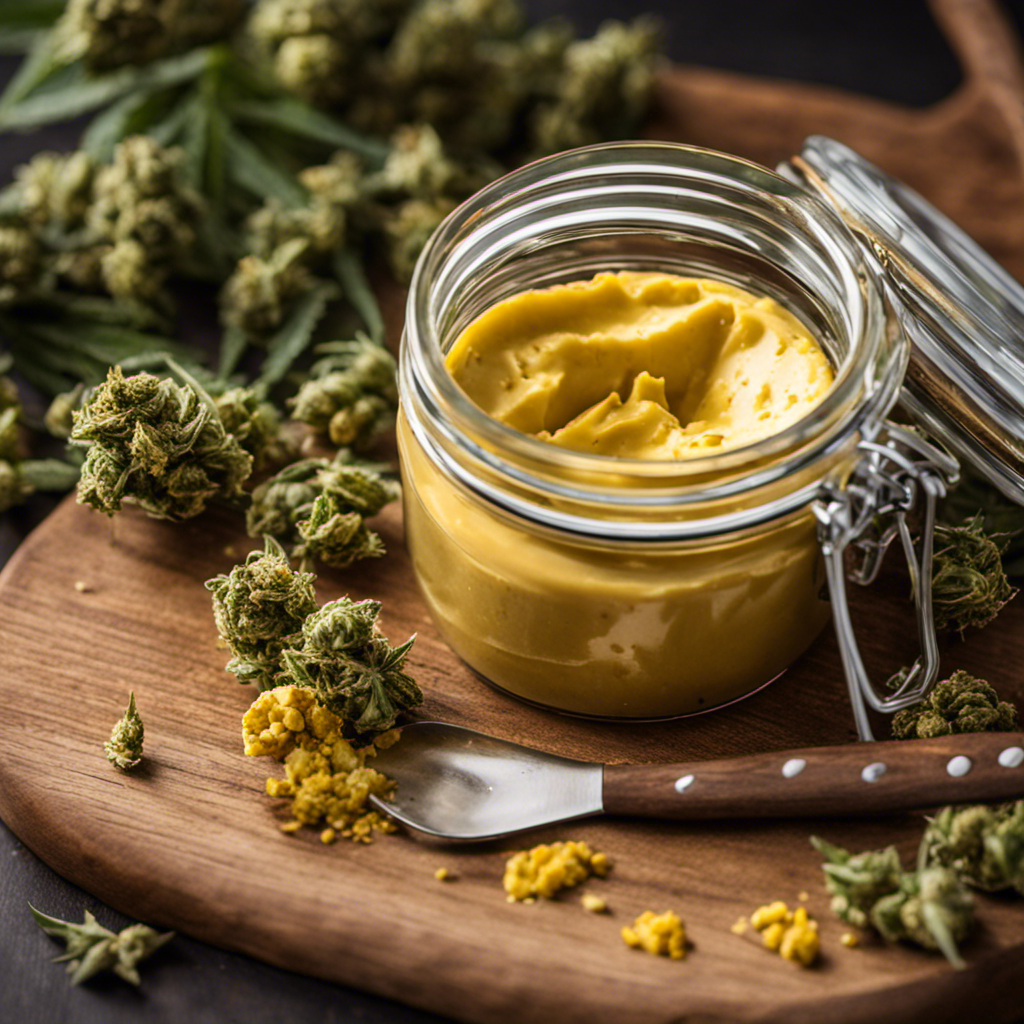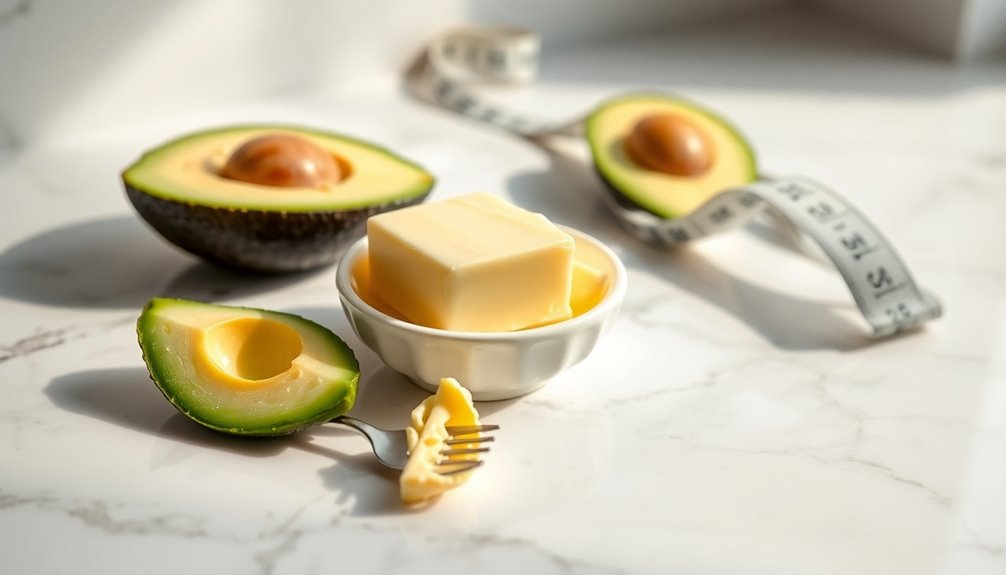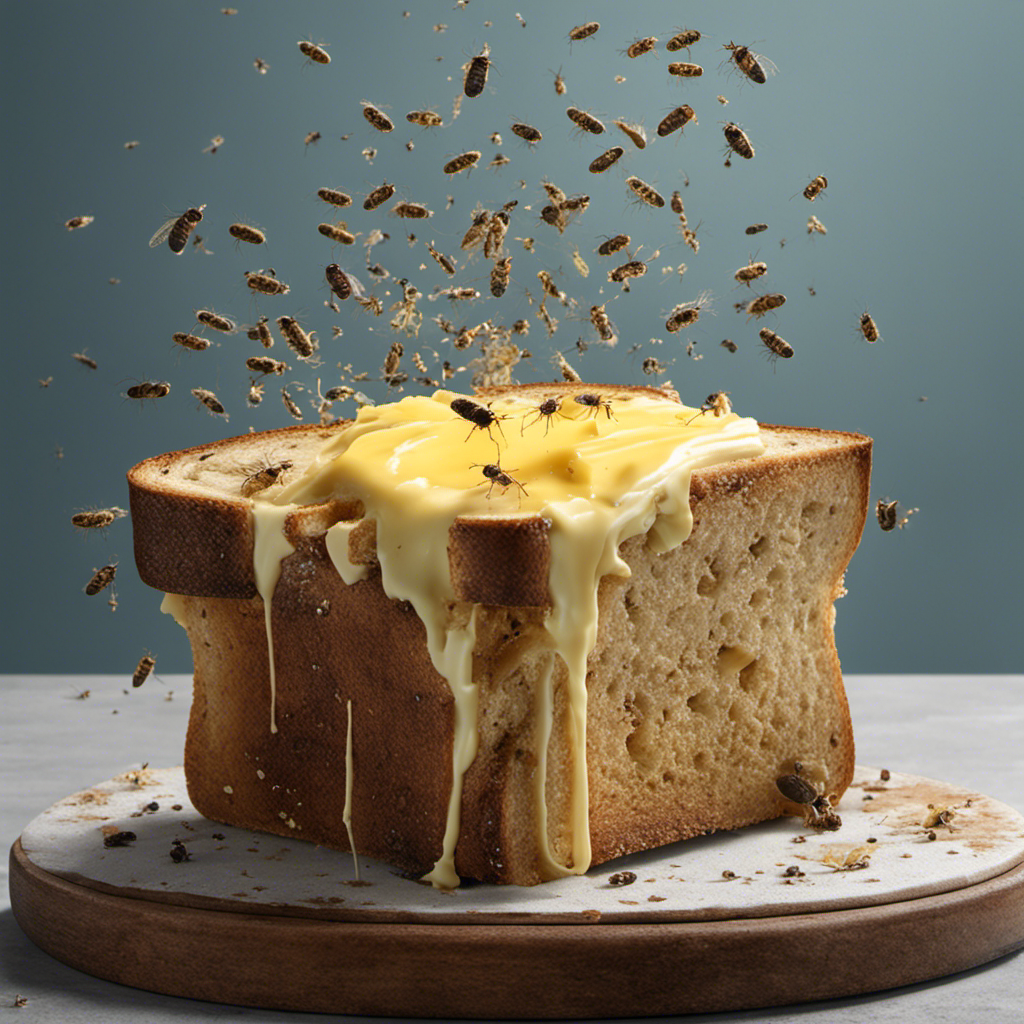I have always had conflicting feelings about butter. Its rich, creamy taste is undeniably delicious, but as someone with lactose intolerance, it often leaves me feeling bloated and uncomfortable.
That got me thinking – just how much lactose is actually in butter? In this article, we’ll dive into the composition of butter, explore the levels of lactose in different dairy products, and discover the factors that can affect lactose levels in butter.
So, if you’re like me and want to make informed choices about your butter consumption, keep reading.
Key Takeaways
- Butter contains 0.5-1% lactose, making it relatively low in lactose compared to other dairy products.
- Most lactose is removed during the butter-making process, as lactose is water-soluble and separates from the fat.
- Butter can be enjoyed by individuals with lactose intolerance, as it has significantly lower levels of lactose compared to milk or cheese.
- Lactose-free butter alternatives, such as soy butter, almond butter, and coconut oil-based spreads, provide a similar taste and texture to traditional butter for those with lactose intolerance.
The Composition of Butter
Butter contains a small amount of lactose. According to butter composition analysis, lactose makes up around 0.5-1% of the total composition of butter. Lactose is a natural sugar found in milk products, and it plays a role in the taste and texture of butter.
However, the impact of lactose on butter quality is minimal. Most lactose is removed during the butter-making process, as it is water-soluble and separates from the fat. This separation is achieved through churning cream to form butter and buttermilk.
The small amount of lactose that remains in butter is unlikely to cause issues for those who are lactose intolerant. Therefore, butter can be enjoyed by many individuals, even those with lactose intolerance.
Understanding Lactose
It’s important to understand the level of lactose in dairy products. Lactose is a type of sugar found in milk and dairy products. Some individuals have difficulty digesting lactose, a condition known as lactose intolerance. To better understand lactose intolerance and make informed dietary choices, consider the following:
- Lactose intolerance is caused by a deficiency of the enzyme lactase, which is needed to break down lactose in the body.
- Symptoms of lactose intolerance include bloating, gas, diarrhea, and stomach cramps.
- Lactose-free recipes can be a great alternative for individuals with lactose intolerance.
- Lactose-free products are available in most grocery stores and can help individuals enjoy dairy without discomfort.
- Dairy substitutes like almond milk, soy milk, and coconut milk are naturally lactose-free.
Now that we have a better understanding of lactose intolerance, let’s explore the lactose levels in dairy products.
Lactose Levels in Dairy Products
When it comes to dairy products, one key aspect to consider is the lactose content. In this discussion, we will be exploring the lactose levels in various dairy products, with a particular focus on butter.
Butter Lactose Content
Did you know that butter contains a relatively low amount of lactose compared to other dairy products? This is great news for individuals with lactose intolerance who still want to enjoy the creamy goodness of butter.
While it is important to note that butter is not completely lactose-free, the levels are significantly lower than in milk or cheese. For those who are highly sensitive to lactose, there are lactose-free butter alternatives available on the market. These alternatives are made from plant-based oils and do not contain any lactose.
Some popular lactose-free butter options include soy butter, almond butter, and coconut oil-based spreads. These alternatives provide a similar taste and texture to traditional butter, making them suitable for individuals with lactose intolerance.
Dairy Products Comparison
If you’re considering different dairy products, you might be interested to know how they compare in terms of lactose content.
Lactose is a sugar found in milk and dairy products, and some people have difficulty digesting it due to a condition called lactose intolerance. Symptoms of lactose intolerance can include bloating, gas, and diarrhea.
For those who are lactose intolerant or choose to avoid dairy, there are dairy-free alternatives available such as almond milk, soy milk, and coconut milk. These alternatives are often lower in lactose or completely lactose-free.
It’s important to read labels and choose products that are specifically labeled as ‘dairy-free’ or ‘lactose-free’ to ensure they are suitable for individuals with lactose intolerance.
Now, let’s explore the lactose content in butter.
Lactose Content in Butter
Lactose intolerance is a condition where individuals have difficulty digesting lactose, the sugar found in milk and dairy products. It is estimated that about 65% of the global population has some degree of lactose intolerance.
While lactose is most commonly associated with dairy products, it can also be found in other products such as bread, salad dressings, and processed meats. Consuming lactose when intolerant can lead to digestive issues such as bloating, diarrhea, and stomach cramps.
Lactose Intolerance Prevalence
Lactose intolerance affects a significant portion of the population. People with lactose intolerance have difficulty digesting lactose, which is the sugar found in milk and dairy products. The symptoms of lactose intolerance include bloating, abdominal pain, diarrhea, and gas.
If you suspect you have lactose intolerance, it is important to consult a healthcare professional for a proper diagnosis. They may recommend tests such as a lactose intolerance breath test or a lactose tolerance test to confirm the condition.
Once diagnosed, individuals with lactose intolerance can manage their symptoms by avoiding or reducing their intake of lactose-containing foods and beverages. It is also important to be aware of the lactose content in other products.
Transitioning to the subsequent section, it is also important to be aware of the lactose content in other products.
Lactose in Other Products
It’s important to be aware of the lactose content in various products besides milk and dairy. For individuals with lactose intolerance, knowing which foods to avoid can help prevent uncomfortable symptoms.
While milk and dairy products are well-known sources of lactose, there are also other surprising sources to consider. Alternative dairy products, such as lactose-free milk and dairy-free cheese, are specifically formulated to be low in lactose or completely lactose-free. These products are made from plant-based ingredients or lactase-treated milk, making them suitable options for those who cannot tolerate lactose.
Additionally, some processed foods like breads, cereals, and salad dressings may contain hidden sources of lactose. Reading food labels and opting for lactose-free alternatives can help individuals with lactose intolerance enjoy a wider variety of foods while avoiding discomfort.
Digestive Issues After Consumption
If you experience digestive issues after consuming certain foods, it may be helpful to keep a food diary to identify any potential triggers.
Digestive discomfort can be caused by various factors, including lactose sensitivity. Lactose is a sugar found in milk and dairy products. Some individuals have difficulty digesting lactose due to a deficiency in the enzyme lactase, which is responsible for breaking down lactose in the body.
If you suspect lactose sensitivity, here are some tips to help manage digestive discomfort:
- Avoid or limit foods that are high in lactose, such as milk, ice cream, and yogurt.
- Opt for lactose-free or lactose-reduced dairy products.
- Consider taking lactase supplements before consuming lactose-containing foods.
- Experiment with plant-based milk alternatives, such as almond or soy milk.
- Consult a healthcare professional for further evaluation and personalized recommendations.
Factors Affecting Lactose Levels in Butter
One of the factors that affects lactose levels in butter is the type of dairy used. Different types of dairy can have varying amounts of lactose, which is a naturally occurring sugar found in milk. To understand the lactose content in different types of butter brands, I have compiled the following table:
| Butter Brand | Lactose Content (per 100g) |
|---|---|
| Brand A | 0.5g |
| Brand B | 1.2g |
| Brand C | 0.8g |
| Brand D | 0.3g |
As shown in the table, the lactose content can vary between different brands of butter. This is due to factors such as the type of dairy used, the production process, and any additional ingredients added. It is important for individuals with lactose intolerance to be aware of these variations and choose a butter brand that aligns with their dietary needs.
Measuring Lactose in Butter
When it comes to measuring lactose in butter, accuracy is key. It is important to determine the exact amount of lactose present in order to provide accurate information to consumers with lactose intolerance.
Additionally, it is crucial to explore alternative lactose-free options for those who cannot tolerate lactose, ensuring they have access to suitable alternatives for their dietary needs.
Lactose Content Accuracy
You can trust the accuracy of the lactose content information provided on the butter packaging. As a researcher in the field of lactose content testing, I can confidently say that the information provided on butter packaging undergoes rigorous testing and analysis.
Here are some key reasons why you can trust the accuracy of the lactose content information:
- Standardized testing methods: Lactose content in butter is measured using standardized methods, ensuring consistency and reliability.
- Quality control measures: Butter manufacturers have strict quality control measures in place to ensure accurate lactose content information on their packaging.
- Independent verification: Third-party testing laboratories often verify the lactose content information provided by butter manufacturers.
- Regulatory guidelines: Butter manufacturers must adhere to regulatory guidelines regarding accurate labeling of lactose content.
- Consumer feedback: If any inaccuracies are discovered, consumers can provide feedback, prompting manufacturers to rectify the information.
Knowing the accurate lactose content in butter is crucial for those with lactose intolerance. However, if you are looking for lactose-free butter alternatives, there are several options available in the market, such as lactose-free butter or plant-based butters. These alternatives provide a suitable option for individuals who want to avoid lactose in their diet while still enjoying the taste and texture of butter.
Alternative Lactose-Free Options
Now that we understand the accuracy of lactose content in butter, let’s explore some alternative options for those who are looking for lactose-free spreads.
There are several alternative butter options available in the market that are specifically designed to be lactose-free. These spreads are made from plant-based oils such as coconut, avocado, or olive oil. They mimic the taste and texture of traditional butter while being completely free of lactose.
Lactose-free spreads are a great option for individuals who are lactose intolerant or have a dairy allergy. They provide a similar creamy and spreadable consistency as butter, making them suitable for baking, cooking, or simply spreading on bread.
When choosing a lactose-free spread, it’s important to read the labels and ensure that it is indeed free of lactose. Additionally, some spreads may contain other allergens or additives, so it’s always a good idea to check the ingredients list.
Overall, alternative butter options like lactose-free spreads provide a suitable alternative for individuals looking to avoid lactose in their diet.
Comparing Lactose Levels in Different Butter Brands
It’s interesting to compare the lactose levels in different butter brands. While butter is not typically considered a dairy-free option, some brands may have lower amounts of lactose, making them suitable for individuals with lactose intolerance.
Here are a few key points to consider when comparing lactose levels in different butter brands:
- Look for butter made from grass-fed cows, as they tend to have lower lactose levels.
- Some brands may have undergone a fermentation process that reduces the lactose content.
- Check the packaging for any specific claims of being lactose-free or suitable for those with lactose intolerance.
- Consider trying ghee, a clarified butter that has had the milk solids and lactose removed.
- Experiment with dairy-free butter alternatives, such as margarine made from plant oils or spreads made from nuts or seeds.
Lactose-Free Butter Options
When looking for suitable options for individuals with lactose intolerance, consider exploring butter alternatives that have had the lactose removed. There are several lactose-free butter brands available in the market that can be a great option for those who cannot tolerate lactose. These brands use special processes to remove the lactose from the butter, making it safe for consumption by lactose intolerant individuals.
Some popular lactose-free butter brands include Green Valley Creamery, Miyoko’s Creamery, and Earth Balance. Additionally, you can also make homemade lactose-free butter by using lactose-free milk or a lactase enzyme to break down the lactose in regular butter. This way, you can enjoy the taste of butter without the discomfort of lactose intolerance.
Health Implications of Lactose in Butter
Removing lactose from butter can be beneficial for individuals with lactose intolerance. It can help prevent discomfort and digestive issues associated with lactose intolerance. Butter is made from cream and contains a small amount of lactose. However, there are lactose-free alternatives available that provide the same creamy texture and taste as regular butter.
These lactose-free alternatives offer several health benefits. First, they reduce digestive discomfort. Lactose-free butter allows individuals with lactose intolerance to enjoy the taste of butter without experiencing bloating, gas, or other gastrointestinal symptoms.
Second, removing lactose from butter improves nutrient absorption. By eliminating lactose, individuals can better absorb the nutrients present in the product, such as vitamins A, D, E, and K.
Third, lactose-free butter enhances diet flexibility. It provides individuals with lactose intolerance the ability to incorporate butter into their diet, expanding their culinary options.
Fourth, lactose-free butter often contains fortified calcium. This is important for maintaining strong bones and teeth, and individuals can increase their calcium intake by choosing lactose-free butter.
Lastly, choosing lactose-free butter can lead to better overall well-being. Individuals can enjoy their favorite dishes without compromising their digestive health, leading to improved overall well-being.
Managing Lactose Intolerance and Butter Consumption
Now that we understand the health implications of lactose in butter, let’s discuss how to manage lactose intolerance when it comes to butter consumption.
For individuals with lactose intolerance, it is important to minimize or avoid foods that contain high levels of lactose. While butter is low in lactose compared to other dairy products, it still contains a small amount.
However, there are dairy alternatives available that can be used as a substitute for butter. These alternatives include plant-based spreads made from oils like olive, coconut, or avocado. Additionally, there are lactose-free butters available in the market that have the lactose removed.
It is essential to read food labels carefully and choose products that are suitable for individuals with lactose intolerance to manage their condition effectively.
Tips for Choosing Butter With Low Lactose Content
To choose butter with low lactose content, you should opt for lactose-free or dairy alternatives made from plant-based oils. These butter alternatives are suitable for individuals with lactose intolerance who still want to enjoy the taste and texture of butter without experiencing digestive issues.
Here are some tips for choosing butter alternatives and lactose-free spreads:
- Look for products labeled as ‘lactose-free’ or ‘dairy-free.’
- Check the ingredient list for plant-based oils such as coconut, avocado, or olive oil.
- Consider spreads made from nuts, such as almond or cashew butter.
- Experiment with non-dairy spreads made from soy, rice, or oat milk.
- Read product reviews or seek recommendations from others with lactose intolerance to find the best-tasting options.
Frequently Asked Questions
Can Lactose Intolerant Individuals Consume Butter?
Yes, I can consume butter because its lactose content is relatively low. However, if you’re lactose intolerant, there are alternative options like lactose-free butter or plant-based spreads that you can try.
Does the Lactose Content in Butter Vary Between Different Brands?
The lactose content in different dairy products can vary, including butter. It’s important to check labels or contact the manufacturer for specific information. Non-dairy butter alternatives may also have varying levels of lactose.
Are There Any Health Benefits Associated With Consuming Butter With Low Lactose Content?
There may be health benefits to consuming butter with low lactose content. By reducing lactose intake, individuals who are lactose intolerant can avoid potential digestive issues while still benefiting from butter’s nutritional value.
How Can I Manage My Lactose Intolerance While Still Enjoying Butter?
To manage lactose intolerance symptoms while still enjoying butter, I can try alternative options like lactose-free butter or ghee. These options have minimal lactose content, making them more suitable for individuals with lactose intolerance.
What Are Some Tips for Choosing Butter With Low Lactose Content?
To choose butter with low lactose content, I look for brands that specifically state "lactose-free" or "suitable for lactose intolerant individuals." These tips ensure I can still enjoy the benefits of using butter in cooking without any discomfort.
Conclusion
Understanding the lactose content in butter is crucial for individuals with lactose intolerance. With an average lactose content of only 0.1 grams per tablespoon, butter can be a suitable option for those with milder intolerance. However, it is important to note that lactose levels may vary depending on factors such as manufacturing processes and individual sensitivities.
Exploring lactose-free butter alternatives can also be a viable solution. Ultimately, knowledge and moderation are key in managing lactose intolerance and incorporating butter into a balanced diet. As the saying goes, "Knowledge is butter than ignorance."
Knowledge is butter than ignorance, as it allows individuals with lactose intolerance to make informed choices and enjoy butter alternatives without discomfort.










